
Since first being detected in the United States in the Pacific Northwest in December 2014, highly pathogenic avian influenza (HPAI) spread across 21 states, affecting 211 commercial and 21 backyard poultry flocks. The last case of the HPAI event of 2015—the spring of 2015 outbreak—was identified in June 2015. To stem the widespread outbreak, the lead federal agency, the U.S. Department of Agriculture’s (USDA) Animal and Plant Health Inspection Service (APHIS), worked with farmers, state and local agencies, and private contractors to depopulate 7.5 million turkeys and 42.1 million egg-layer and pullet chickens. Overall, federal expenditures on the outbreak totaled about $879 million, including roughly $610 million for depopulation, cleaning, and disinfection, together with indemnification at 100% of the fair market value of the birds totaling $200 million. The remainder was overtime, travel, supplies and fall planning costs.
Did the costs of these government efforts result in net social welfare benefits to the U.S. economy? In general, to answer that question, policy analysis will examine measures of consumer surplus and producer surplus. For example, the Office of Management and Budget’s Circular A-4 describes the cost of a policy as being “the net reduction in the total surplus (consumer plus producer) is a real cost to society.” Consumer surplus is the difference between the amounts consumers would be willing to pay for a good versus the prices they actually pay. Producer surplus measures the net gain that producers receive for producing and selling a good.
However, in the case of HPAI, while changes in consumer surplus can be estimated, we consider only changes in producer surplus in evaluating the domestic benefits of addressing HPAI. Why is that? Although consumers are the ultimate beneficiaries of efforts to reduce losses from animal diseases, including only domestic consumer benefits in a benefit-cost assessment results in counter-intuitive and potentially counterproductive results for purposes of HPAI policy evaluation. In particular, because the United States is a net exporter of poultry products, especially broilers, bans by our trading partners on importation of U.S. poultry products benefit U.S. consumers due to larger domestic supplies and lower U.S. prices. But U.S. producers are made worse off by trade losses, and the U.S. economy as a whole suffers even though U.S. consumers receive a windfall benefit from lower prices and higher consumption. Thus, we compare producer benefits to the costs for depopulation, cleaning, disinfection, and indemnification for the spring 2015 HPAI outbreak.
How do we measure the benefits of government efforts to control the spread of HPAI? Absent such a response, simulation modeling suggests that HPAI outbreaks would have been even more widespread and costly. This is because a key component to disease response is early identification of infected birds and immediate depopulation of those flocks to limit potential spread to nearby farms. Without government resources to help producers quickly identify infected animals, to provide indemnification of the flock, and to assist with cleaning and disposal costs, it is likely that producers would not self-identify their farms as being infected as urgently or might attempt to continue moving birds. In those cases, modeling suggests a wider spread of the disease, additional lost production, and likely additional loss of export markets for poultry products in general.
To estimate the impacts of HPAI on agricultural producers and markets, an epidemiological model of disease spread was combined with a quarterly economic model of the U.S. livestock and feed economy. In tandem, the models simulated the economic impacts of the spring 2015 outbreak and alternative response scenarios for the period from December 2014, when HPAI was first confirmed, through December 2017, when markets are expected to return to their pre-outbreak forecasts.
The conceptual model provided by InterSpread Plus v.5 (Stevenson et al., 2013) was used as the framework for developing a U.S. national scale model of HPAI. This HPAI disease spread model simulates the daily path outbreaks might take through the U.S. poultry population under alternative control measures. Different detection and surveillance options as well as depopulation, disposal, cleaning, and disinfection methods are combined into individual “scenarios”, and each scenario is run through the model repeatedly to capture a range of uncertainty in how the disease and the control measures might behave. The outputs of running these scenarios include the number of birds that die, their location, and the length of the outbreak for each scenario. This output is then fed into a quarterly economic model of the U.S. livestock and feed sectors (Paarlberg et al., 2008) to reflect the disease impact, or shock, to poultry and poultry products production and international trade. The economic model is then run to estimate how market prices for all livestock and feed will change as a result of the outbreak and how these price changes affect the supply and use of livestock, their products, and their feeds.
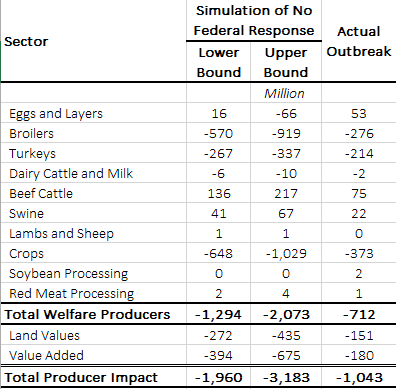
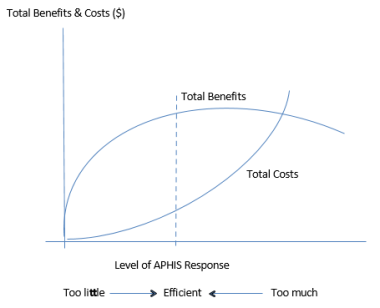
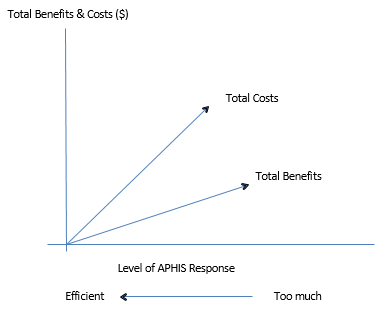
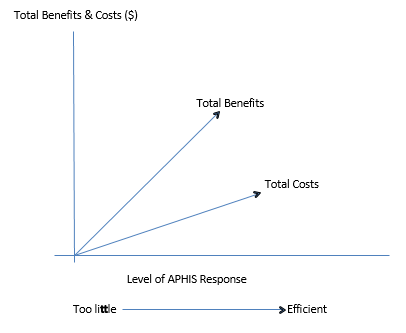
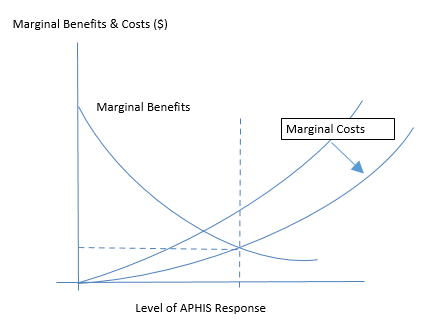
Estimated net losses to U.S. livestock and feed producers and processors due to the spring 2015 HPAI outbreak were $712.1 million (Table 1). Estimated declines in land values and value-added were $330.9 million. Adding those together, the estimated impact on the U.S. livestock and feed sector was $1.04 billion in losses. Assuming no government eradication and control efforts, epidemiological models coupled with economic modeling suggest producer losses from the spring 2015 HPAI outbreak could have ranged from $1.96 billion to $3.18 billion. Based on that modeling, government led efforts limited producer losses that otherwise would have occurred by between $920 million to $2.14 billion, with a midpoint of $1.53 billion. Thus, considering only the reduction in economic losses to domestic producers, the estimated net benefit of approximately $879 million in federal spending on disease control and eradication was between −$120 million to $1.10 billion, with a midpoint of $490 million. In other words, over most of the range of simulated impacts, the estimated benefits of avoided losses from government led efforts exceeded actual federal outlays on those efforts leaving room for additional response expenditures by state and local governments.
While simulations of the economic impacts of the spring 2015 outbreak indicate positive net benefits to producers relative to taxpayer costs, the results do not tell us whether the federal, state, and local responses should have been more aggressive or less aggressive. From a planning perspective, marginal costs equal to marginal benefits will occur when the total cost curve measuring disease control and eradication efforts is furthest below the total benefits curve (Figure 1). We would say that at levels of effort below that point, net benefits of control—total benefits minus total costs—could be increased by increasing government efforts. Conversely, at levels of government effort past that point, net societal benefits could still be positive, but could be increased by lower levels of efforts. Under our framework, optimal effort would occur when an additional dollar spent on disease detection and eradication generates an additional dollar of prevented losses to agricultural producers. From the perspective of taxpayer cost versus producer benefit, this represents the optimal level of government efforts.
The coordinated effort is essentially the expected costs to government authorities to adopt a particular control and prevention strategy for a disease event or season, such as during the spring or fall and winter migration of wild ducks and geese from Canada to Mexico and back. That is to say, we model this response as a strategy that would be adopted throughout the course of a disease event or in preparation for a potential disease event. We do not model government effort as a sequential activity where at some point in time it would make sense for governmental agencies to move from a control strategy of expending government resources to a non-control strategy of withdrawing government efforts. There may be some control strategies that have activities that are contingent on the extent of a particular outbreak, however. For example, consider the case when the outbreak is particularly virulent, or the benefit curve was to shift upwards. In those cases, USDA-APHIS as a coordinating agency would likely argue for a new strategy that addressed that new total benefit function.
Note that there are additional considerations that do not show up in this depiction. Equity concerns may exist in limiting indemnification and offsetting cleaning and disinfection services for some producers, but not all producers—see the discussion on tipping points below. That approach would particularly be true if the policy were changed without notice and could impair efficient notification by producers of future infections to the agency. The role of uncertainty regarding disease spread is not explicitly addressed in this framework. However, solving the epidemiological model for multiple repetitions takes into account the role that chance plays in disease spread. Inserting the results of multiple repetitions of the epidemiological model into the economic model produces a range of estimates reflecting uncertainty about the spread of disease among farms and across time.
Two special cases exist from the earlier depiction (Figures 2a and 2b). Figure 2a, exhibits the case when there is no level of effort that generates positive net benefits. That is, you will always be spending more to limit losses than you actually do to reduce losses. As a result, no efforts should be undertaken.
While we argue against including economic measures of domestic consumer welfare in terms of assessment of U.S. HPAI control efforts, we recognize that avian diseases do have the potential to spread to humans if allowed to spread without any control actions. Therefore, it is unlikely that the United States will ever allow a “no action” approach, since potential human health risks, however remote a possibility, require USDA intervention. Moreover, the Department of Health and Human Services (HHS) or the Department of Homeland Security (DHS) would likely become more involved if USDA were to stop control actions. In other words, zero federal spending and zero avoided loss from that spending is unlikely to be realized.
Similarly, federal, state, and local government agencies are responsible for protecting the health, quality, and marketability of the nation’s animals. If government did not act in a manner consistent with that mission, public confidence in U.S. animal health and food safety would decline. Similarly, the international reputation that facilitates trade between the U.S. and our export markets would be tarnished and trade regionalization efforts, included permitted movement of low risk product, would be limited as a result. The costs of those would far outweigh any potential savings on scaled back efforts to control HPAI in the U.S. poultry sector.
Alternatively, in figure 2b, in the case when total benefits always exceed total costs, the response should always be at the maximum amount since you are always generating more benefits than you are spending. A case could be envisioned, such as bovine spongiform encephalopathy (BSE), when the costs of eradication are very high, but the uncertainty to human health drives the benefit function to a much higher level justifying maximum efforts.
Are there ways to more efficiently use the budgetary resources to lower the costs of the current aggressive responses? Additional more aggressive efforts are also more efficient if the marginal costs of the government efforts become lower (Figure 3). This can be thought of as contracting for services ahead of time so that scarcity values—temporal price discrimination—do not drive up response costs. While it is likely that those more aggressive efforts would be more costly, it is also clear that some of those costs are mitigated by pre-planning and pre-determination of cleaning and disposal rates, relative to the spring 2015 case (USDA, 2016). While such preparatory effort entails additional federal costs, simulating alternative scenarios allows us to shed light on the effectiveness of those efforts in terms of disease spread and the resulting costs to producers and taxpayers.
Following the devastating losses from the spring 2015 outbreak, federal, state, and local governments engaged in extensive planning efforts with industry, and international partners in preparation for a potential reoccurrence of the disease (USDA, 2016). To aid in planning, USDA, APHIS examined the potential impacts of alternative control strategies assuming a widespread outbreak involving multiple states and production sectors (USDA, 2015). The analysis modeled the epidemiologic and economic effects of alternative strategies varying factors influencing disease spread and control: (a) depopulation capacity and time required for cleaning and disinfection (C&D); (b) detection and reporting of disease by poultry producers; and (c) biosecurity.
Simulations were conducted assuming widespread introduction of HPAI into the domestic poultry population at 20 geographically dispersed sites over a 50-day period. Under the spring 2015 simulations, net benefits to disease response efforts of approximately $500 million were generated when the spread of the disease affected approximately 50 million birds. However, in the fall 2015 preparedness and planning scenarios, APHIS simulated an outbreak roughly three times larger than the outbreak in the Spring 2015.
Epidemiologic results showed that the greatest reductions in the number of birds requiring depopulation would be achieved by combining the best depopulation capacity seen during the spring 2015 outbreak with the best disposal capacity together with improved producer reporting and improved biosecurity. Those changes together would decrease the median number of farms infected to about 350 with 27 million birds affected compared to more than 2,500 farms and 183 million birds affected in the baseline scenario assuming average depopulation and disposal capacity observed during the spring 2015 outbreak. Moreover, doubling depopulation and disposal capacity would result in a further 20% reduction in the overall number of birds requiring depopulation.
The fall 2015 simulation exercise showed potential economic losses to the livestock and feed sectors of up to $6.2 billion. For a response similar to the spring 2015 outbreak, economic impacts for the median scenarios indicate producer losses of $3.3 billion, or a benefit of roughly $2.9 billion. Given these scenarios consider an outbreak that is three times larger than the spring 2015 outbreak, costs of response could approach $3 billion for such a scenario. Producer losses can be lowered by an additional 40%, to $2.1 billion, with improved depopulation and disposal capacity coupled with improved producer reporting and biosecurity, an overall benefit of $4.1 billion. Doubling depopulation and disposal capacity would result in further reductions in producer losses down to $1.3 billion, a benefit of $4.9 billion.
In sum, fall 2015 simulations suggest that benefits of up to $3 billion are available under efforts similar to spring 2015 and as much as $5 billion under more aggressive response efforts, depending on our trading partners’ responses to our disease control efforts. A scenario in which vaccines are deployed could substantially increase the potential loss to agricultural producers if Asian markets fully embargo U.S. exports of poultry meat rather than taking the regionalization approach some did in the spring 2015 outbreak. Modeling of HPAI vaccination tentatively indicate that in densely populated poultry areas benefits of vaccination in terms of disease reduction, lower depopulation and virus elimination costs, and reduced consumer reaction to disease control efforts may outweigh the additional costs of implementing vaccination and wider regional, as opposed to state level, exporter bans. Because we can only conjecture the reactions of our trading partners as well as uncertainty around the costs of a vaccination program, it is difficult to build a decision tree that would account for all possible scenarios leading to a decision whether to trigger the deployment of vaccines. Thus, the more viable option is to establish a framework for decision making that accounts for the extent of actual disease spread, costs and success of control efforts, and likely reactions of trading partners.
However, based on paying for virus elimination through a flat rate system which compensates producers equal amounts per type of bird, the increased speed of response, and the expanded capacity for depopulation, the response costs per affected bird is expected to be lower in a future outbreak (USDA, 2016). Therefore, the increased government efforts described above for responding to a larger potential outbreak as well as industry biosecurity efforts should result in higher net welfare benefits.
Arguably, there may be a “tipping point” beyond which further federal efforts to stem the spread of HPAI should cease, at least in terms of measurement of economic costs and benefits to society. In other words, is there a point at which the actual costs of addressing an HPAI outbreak exceed the actual benefits to society, as would be the case beyond the point which the total benefits and total costs curves intersect in Figure 1? While measuring costs of government disease control efforts as they are incurred is a fairly straightforward exercise, the measurement of actual benefits during an outbreak with precision is difficult given uncertainties about the level of epidemic spread and the trade response. In the midst of an HPAI outbreak, it is unlikely the benefits could be known in order to judge the marginal benefits of additional actions. Given that disease spread is a process that depends, to some degree, on nothing explainable other than pure chance, uncertainty about further disease spread surrounds the outcome of any decision to continue federal intervention.
Furthermore, a number of consequences would result from changing government efforts to address HPAI in the middle of an outbreak. A key to understanding this issue is how the government response is viewed by our global trading partners, as discussed above. In the case of a response to HPAI that is interpreted as the disease becoming endemic to the United States, it is likely that we would lose more of our trading partners. Our trading partners likely would respond negatively to any reduction in HPAI control efforts. Nationwide trade embargoes likely would replace any regionalized trade restrictions put in place by our trading partners, leading to sharp drops in exports. Additionally, there are economic arguments that suggest allowing the global reputation of the United States to suffer in the wake of a “no action” scenario would far outweigh the current budgetary outlays envisioned for government actions on HPAI.
In addition, changing government efforts, such as by limiting indemnities or cleanup costs after a certain point, could present moral hazard issues in addition to raising equity and fairness issues among farmers hit by HPAI. For example, suppose farmers whose flocks were infected before a tipping point was reached received indemnity payments and coverage of disposal, cleaning, and disinfection costs, but farmers whose flocks were infected afterward received less assistance. That could encourage producers to report HPAI infection earlier. However, if federal funds are only forthcoming to producers hit by HPAI prior to the tipping point, then producers with a high probability of getting hit could face conflicting incentives in pursuing biosecurity efforts. Such a policy for HPAI response would have similar spillover effects for other animal diseases as well.
The more useful approach in the short term or in the midst of an outbreak is to evaluate the expected costs and benefits of alternative control strategies, as previously discussed. Strategies with positive expected net benefits are worth pursuing on economic grounds, while strategies with expected costs exceeding benefits should generally be avoided.
Office of Management and Budget. 2003. Circular A-4. Washington, D.C., 17 September. Available online: https://www.whitehouse.gov/omb/circulars_a004_a-4/.
Paarlberg, P.L., A.H. Seitzinger, J.G. Lee, and K.H. Mathews, Jr. 2008. Economic Impacts of Foreign Animal Disease. U.S. Department of Agriculture, Economic Research Service Report No. 57, Washington, D.C.
Stevenson, M.A., R.L. Sanson, M.W. Stern, B.D. O’Leary, M. Sujau, N. Moles-Benfell, and R.S. Morris. 2013. “InterSpread Plus: A Spatial and Stochastic Simulation Model of Disease in Animal Populations.” Preventative Veterinary Medicine 109:10-24.
U.S. Department of Agriculture (USDA). 2015. Modeling Alternative Control Strategies for HPAI. Animal and Plant Health Inspection Service, Veterinary Services, Washington, D.C., 1 September. Available online: https://www.aphis.usda.gov/animal_health/downloads/animal_diseases/ai/hpai-modeling-alternative-control-strategies.pdf.
U.S. Department of Agriculture (USDA). 2016. 2016 HPAI Preparedness and Response Plan. Animal and Plant Health Inspection Service, Veterinary Services, Washington, D.C., 11 January. Available online: https://www.aphis.usda.gov/animal_health/downloads/animal_diseases/ai/hpai-preparedness-and-response-plan-2015.pdf.